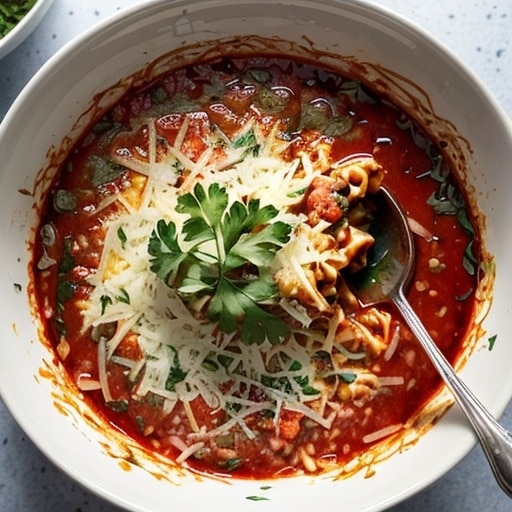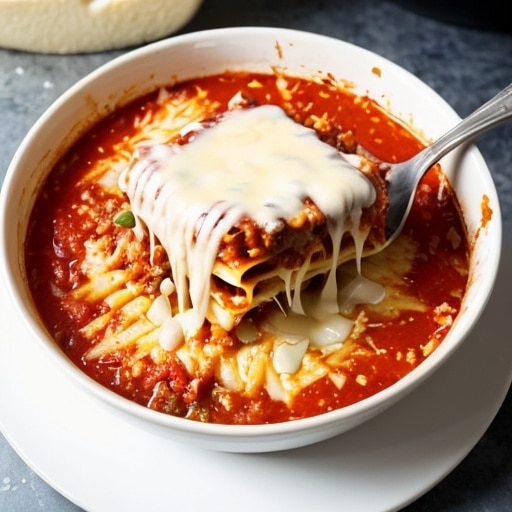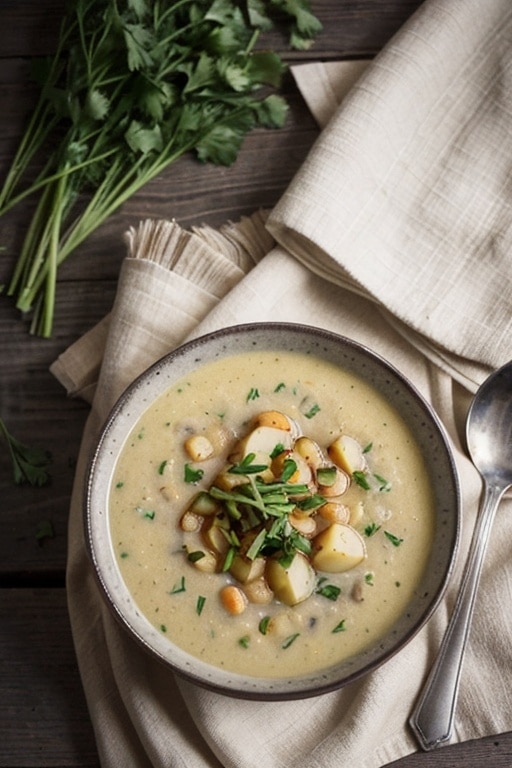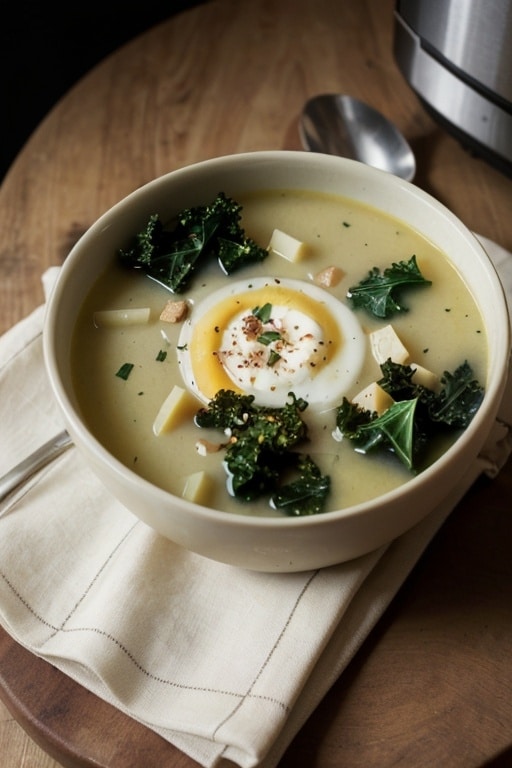Have you ever had a dish that warms your soul and brings back fond memories of family gatherings? That’s what happens when you dig into a bowl of lasagna soup. It’s the comfort of lasagna, but in a cozy, slurpable form. This recipe takes a beloved classic and gives it a delightful twist, making it perfect for cold nights or casual dinners with friends.
What makes this lasagna soup unique? The secret ingredient! It adds a depth of flavor that takes this dish from ordinary to extraordinary. It’s not just about the layers; it’s about the layers of flavor, too. Let’s dive into the details of how to create this heartwarming dish.

Ingredients & Substitutions
Essential Ingredients
- Ground Beef or Sausage: For the protein base. Choose lean ground beef or spicy Italian sausage for extra flavor.
- Onion: Chopped, for aromatic depth.
- Garlic: Minced, to add that essential savory note.
- Bell Pepper: Chopped, adds sweetness and color.
- Canned Tomatoes: Diced tomatoes, for the saucy base.
- Tomato Sauce: Provides richness and helps bind everything together.
- Vegetable or Chicken Broth: For the liquid base; it enhances the flavor.
- Lasagna Noodles: Broken into pieces. You can use regular or whole wheat.
- Cottage Cheese: Here’s the secret ingredient! It adds creaminess and a tangy flavor.
- Mozzarella Cheese: Shredded, for that gooey topping.
- Italian Seasoning: A blend of herbs that brings everything together.
- Red Pepper Flakes: Optional, for a spicy kick.
- Fresh Basil: For garnish, adds color and freshness.
Quality Substitutions
- Meat: For a vegetarian version, use lentils or mushrooms instead of meat. They provide texture and flavor.
- Cottage Cheese: If you’re not a fan, ricotta can be used instead, but it will change the texture slightly.
- Broth: Use vegetable broth for a vegetarian option.
Choosing fresh ingredients is crucial. Fresh garlic and herbs have a more vibrant flavor than dried, elevating your dish significantly.

Step-by-Step Instructions
Sautéing the Base
- Heat the Pot: In a large pot, heat about 2 tablespoons of olive oil over medium heat. This will be the foundation for our flavors.
- Cook the Ground Meat: Add the ground beef or sausage. Cook until browned, breaking it up with a wooden spoon. This should take about 5-7 minutes. Browning adds depth through the Maillard reaction.
- Add Onion and Bell Pepper: Once the meat is browned, stir in the chopped onion and bell pepper. Cook until softened, about 5 minutes. This builds the aromatic base.
Building the Soup
- Add Garlic: Stir in the minced garlic and cook for another minute. You want it fragrant but not burnt.
- Incorporate Canned Tomatoes: Pour in the diced tomatoes and tomato sauce. Stir well to combine. The acidity of the tomatoes balances the richness of the meat.
- Add Broth: Pour in the broth. Bring the mixture to a simmer. This will help meld the flavors together.
Cooking the Noodles
- Add Lasagna Noodles: Break the lasagna noodles into smaller pieces and add them to the pot. Stir to ensure they’re submerged. Cook for about 10-12 minutes, until the noodles are tender.
- Season the Soup: Add Italian seasoning, salt, pepper, and red pepper flakes if using. Taste and adjust seasoning as needed.
Finishing Touches
- Stir in Cottage Cheese: Once the noodles are cooked, remove the pot from heat and stir in the cottage cheese. This is the secret ingredient that adds creaminess and a hint of tang.
- Add Mozzarella: Top with shredded mozzarella cheese. If you want, you can put the pot back on low heat until the cheese melts.
Expert Tips
- Avoid Overcooking the Noodles: Keep an eye on them; you want them al dente. They’ll continue to soften in the soup.
- Common Mistakes: Don’t skip the browning step for the meat. It adds essential flavor.
Variations
For a different flavor profile, try adding spinach or kale for some greens. If you love heat, consider adding diced jalapeños along with the onions.
Cooking Techniques & Science
Understanding why certain methods are used can elevate your cooking. Browning the meat creates a rich base through the Maillard reaction, which enhances flavor. The addition of cottage cheese not only thickens the soup but also adds a creamy texture that complements the acidity of the tomatoes.
Using broken lasagna noodles instead of traditional pasta allows for a more rustic feel, and they soak up the flavors beautifully. The simmering process melds all the ingredients together, which is key for a delicious soup.
Tools You’ll Need
- Large Pot: A sturdy pot is crucial for even cooking and simmering.
- Wooden Spoon: Ideal for stirring without scratching your pot.
- Measuring Cups and Spoons: For accuracy in your ingredients.
Serving & Pairing Suggestions
Presentation can make a difference. Serve the soup in deep bowls, garnished with fresh basil and a sprinkle of extra mozzarella. A drizzle of olive oil on top can enhance the flavors even more.
Pair this dish with a simple side salad dressed in vinaigrette for a light contrast. A slice of crusty bread or garlic bread is perfect for dipping. For drinks, a light red wine, like Chianti, complements the flavors nicely. A sparkling water with a squeeze of lemon can also refresh the palate.
Conclusion
Secret Ingredient Lasagna Soup is a delightful twist on a classic dish. It combines the comforting flavors of lasagna with the convenience of soup, making it perfect for any occasion.
Remember, the secret ingredient—cottage cheese—adds a creaminess that elevates the dish. With just a few simple steps, you can create a warm and satisfying meal that everyone will love.
Final Tips
- Leftovers: Store any leftovers in an airtight container in the fridge for up to three days. The flavors will deepen overnight.
- Experiment: Don’t be afraid to try different meats, cheeses, or vegetables. The beauty of this recipe is its versatility.
FAQs
1. Can I use homemade broth?
Absolutely! Homemade broth adds a depth of flavor that store-bought can’t match.
2. How can I make this soup vegetarian?
Simply replace the meat with lentils or mushrooms and use vegetable broth instead.
3. What if I don’t have cottage cheese?
You can substitute ricotta cheese, but the texture will be a bit different.
4. Can I freeze this soup?
Yes! Portion it into freezer-safe containers. Just thaw and reheat when you’re ready to enjoy.
5. How do I store leftovers?
Keep them in an airtight container in the fridge for up to three days. Reheat gently on the stovetop or in the microwave.

Catherine Frank is the creative force behind FoodieGrandie.com, a cozy corner of the internet where she shares her love for home-cooked meals. From hearty dinners to sweet desserts, her recipes bring warmth and flavor to every table. Passionate about simple, delicious food, Catherine turns everyday meals into memorable moments.



